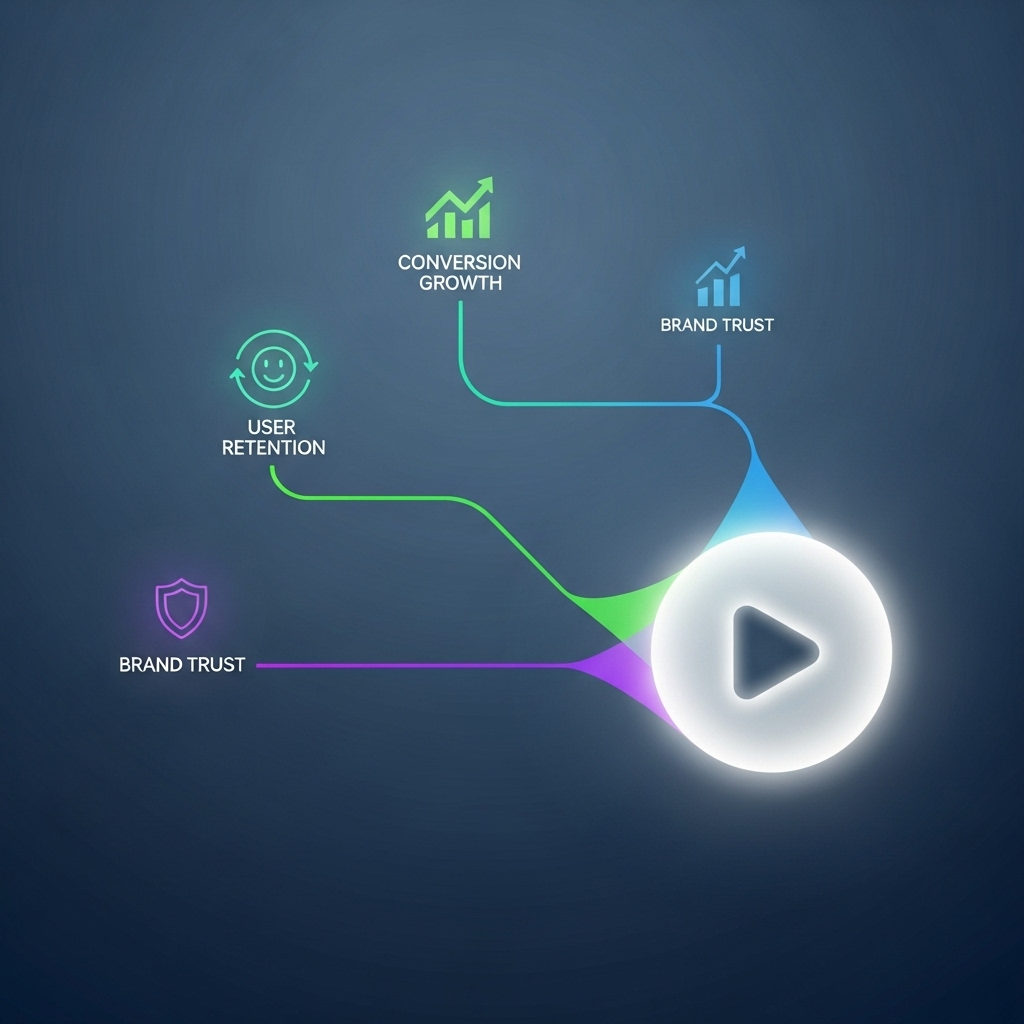The ROI of a World-Class Video Experience: A Strategic Guide for Product Leaders
A guide for product leaders on how video quality impacts user retention, conversion, and brand perception. Learn the business case for video infrastructure.

In today’s digital landscape, video is no longer a “nice-to-have.” It’s a fundamental driver of user engagement, education, and conversion. But simply embedding a video on your site is not a strategy—it’s a checkbox. A poor video experience can do more harm to your brand and your bottom line than no video at all.
This guide is for the leaders—Product Managers, CTOs, and Founders—who need to make strategic decisions about technology investment. We will break down how three critical aspects of the video experience directly map to tangible business outcomes and explore the classic “build vs. buy” dilemma for video infrastructure.
The Trinity of Video User Experience
A user’s perception of your brand is shaped by their experience. For video, this experience boils down to three key moments:
- Time to First Frame (TTFF): How long does it take from clicking “play” to seeing the first frame of video?
- Buffering Events: How often does the video pause to load during playback?
- Visual Quality: How crisp and clear is the picture on the user’s specific device?
Let’s analyze the business impact of optimizing each one.
1. Time to First Frame: The Battle for Attention
In an era of infinite scroll and fleeting attention, the first few seconds are everything.
- The Psychology: A long TTFF creates immediate friction and doubt. It makes your application feel slow and unresponsive. According to Google research, the probability of a user bouncing increases by over 30% if a page takes 3 seconds to load. The same principle applies to video.
- The Business Impact:
- Increased Drop-off Rate: Users will abandon the video before it even starts.
- Lower Engagement: A sluggish start discourages users from interacting further with your content or product.
- Negative Brand Perception: Your brand is perceived as slow and unprofessional.
The Solution: Optimizing for TTFF involves a combination of a fast CDN, a lightweight video player, and starting the stream with the lowest quality version of the video first, then upgrading.
2. Buffering: The Conversion Killer
The buffering wheel is the single most destructive element in video UX.
- The Psychology: Buffering is an interruption that breaks a user’s flow state. It’s frustrating and signals unreliability. Each buffering event is an “exit ramp” from your content.
- The Business Impact:
- Plummeting Watch Time: Studies have consistently shown that even a 1% increase in buffering leads to a significant decrease in total watch time.
- Reduced Conversion: If a product demo video buffers, the user loses confidence in the product itself. If an educational video buffers, the user loses their train of thought and gives up.
- Higher Churn: For subscription-based services, a poor playback experience is a leading cause of customer churn.
The Solution: The definitive solution to buffering is Adaptive Bitrate Streaming (ABS), a technology that intelligently adjusts the video quality in real-time to match the user’s network speed.
3. Visual Quality: Meeting User Expectations
Delivering a blurry, pixelated 360p video to a user on a 4K monitor is just as bad as buffering.
- The Psychology: Users expect a premium experience. When the visual quality doesn’t match the context of their device, it feels cheap and jarring. It undermines the perceived value of your content and your product.
- The Business Impact:
- Eroded Trust: If your marketing video is low quality, what does that say about the quality of your product?
- Ineffective Communication: Important details in a tutorial or demo video can be lost if the resolution is too low.
- Competitive Disadvantage: Your competitors are likely delivering a high-quality experience. A subpar one makes your brand look second-rate.
The Solution: A robust transcoding pipeline that creates a wide range of renditions, from low-resolution mobile versions to high-definition 1080p or even 4K streams, served intelligently via ABS.
The Strategic Dilemma: Build vs. Buy
Understanding the importance of the UX trinity leads to a critical infrastructure question: should your engineering team build this complex pipeline, or should you buy a solution by integrating a video API?
The “Build” Argument (and its Hidden Costs)
Building it yourself seems to offer maximum control. However, the true cost is far more than just engineering salaries.
- Time to Market: A production-ready video pipeline can take 6-12 months to build, delaying your core product roadmap.
- Infrastructure & Maintenance Costs: This includes server costs for processing, storage costs (S3), and CDN bandwidth costs. These are significant and ongoing.
- Opportunity Cost: The most critical cost. Every hour your best engineers spend debugging FFmpeg or configuring a CDN is an hour they aren’t spending on the unique features that differentiate your business.
- Expertise Gap: Video engineering is a highly specialized field. Your team will have to learn a new and complex domain on the fly.
The “Buy” Argument: Accelerating Your Roadmap with Snapencode
Integrating a dedicated video platform like Snapencode turns the entire infrastructure problem into a predictable, scalable operating expense.
- Instant Expertise: You get a world-class, battle-tested video pipeline on day one.
- Focus on Core Value: Your engineering team can focus 100% on building your application’s unique features.
- Predictable Costs: You pay for what you use, transforming a large, risky capital expenditure into a manageable operational expense.
- Future-Proofing: As video technology evolves (new codecs like AV1, new streaming protocols), the platform handles the upgrades. Your application stays modern without any additional engineering effort.
By choosing to integrate an API, you are not just buying technology; you are buying speed, expertise, and focus—the three most valuable resources for any growing company.
Want to see how a video API can impact your roadmap? Talk to our team about your use case or read how we helped a similar company solve this problem .